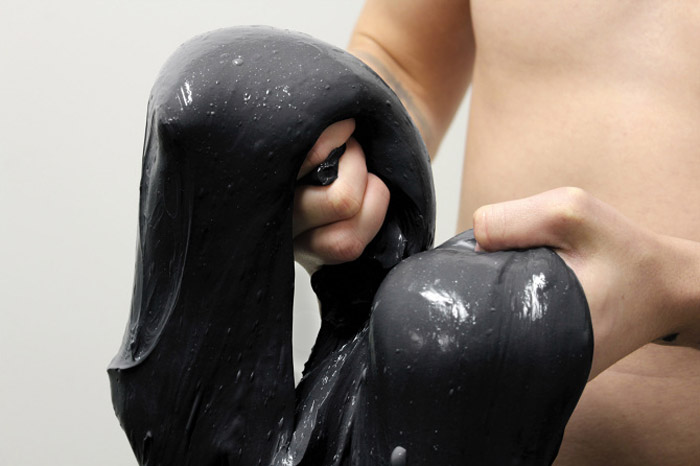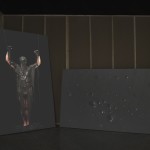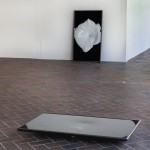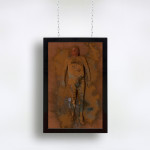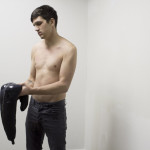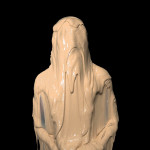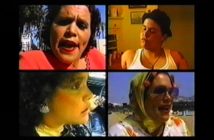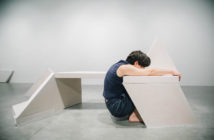Ryan Hawk is a visual artist working with performance, video, sculpture and critical theory, who is interested in exploring the corporeal effects of power and knowledge as they relate to art history, sexuality and the politics of desire . After receiving his BFA from the School of the Museum of Fine Arts, Boston, in 2013, he is currently pursuing his MFA at the University of Texas, Austin. Ryan Hawk is a recipient of the 2016 Traveling Fellowship, an award granted yearly to alumni of the School of the Museum of Fine Arts, Boston, to fund travel in support of art making. He recently spoke with Maia Dolphin-Krute about the Fellowship and his upcoming travel.
Maia Dolphin-Krute: To start, can you tell us about your travel plans for the Fellowship program? I've been familiar with your work for several years so I would be interested to hear how your current plans and the related project fit into your practice.
Ryan Hawk: For the Traveling Fellowship I will be traveling to the world’s largest natural asphalt deposit, Pitch Lake in La Brea, Trinidad. I will be traveling between Trinidad and Austin several times over the next few months. This project is particularly exciting to me because it’s the first time I plan to engage my practice beyond the context of my studio at such a large scale. As you know, most of my work has been situated almost entirely within my studio or a prescribed art exhibition space and, more frequently than not, my own body. Whereas previously I was only concerned with making images through my own body due to fear of objectifying others, I’ve recently started employing other bodies through a specific methodology I devised to explore the very politics of objectification and power-relations within systems of art-making. This method consists of me utilizing willing submissive men within the context of a BDSM power-relationship to make performances for the camera. I’ve been really excited about this change in my work. Shifting my attention to a landscape for this new project, I have similar anxieties about engaging something unfamiliar and distant. The Pitch Lake is a very different type of body. Although, it is certainly some type of body; constantly moving, with history, depended upon by people, etc. It’s not a new concept to regard a landscape as a body, but I’m interested in these various interrelated contradictions of corporeality and language nonetheless. I fully anticipate my project in Trinidad to be more transformational to my existing practice than to be an extension of it!
What led you to Pitch Lake? What kind of knowledge or experiences do you hope to gain there that could not have been satisfied by other kinds of research?
My initial desire to travel to Pitch Lake was very specifically located within a material fascination with the asphalt from the lake. The pitch strikes a direct resemblance to GAK Polymer, a material I’ve used for about three years within my work due to its unique flesh-like resonance and slow viscous tendency to swallow everything it touches. After first learning of the lake’s existence about two years ago, my fascination quickly grew into an obsession; I’ve conducted about as much research as possible via the internet and academic outlets. As a result, my interests have now broadened to include a curiosity for the lake’s mythology as described by Trinidadian folklore and the industrialization of the pitch for the production of asphalt. So you can imagine why I feel the need to physically go there; getting as close to the pitch as possible, engaging with those who live and work by the lake, and hopefully gaining the type of knowledge that can only result from a very physical experience is what I hope for.
Do you have a specific set of exercises or projects for each trip?
No, I haven't planned any set exercises or micro projects as of now, but I imagine those will come later as I shift from research to production. My first few trips are aimed at just getting close to the pitch and finding as many ways as possible to experience it’s materiality. I also really hope to connect with as many people as I can, especially those who work or live closely to the lake. Lastly, I really look forward to experiencing the contemporary art scene in Trinidad.
Can you talk a bit about what kind of research you’ve been doing in preparation?
All of the usual 21st century stuff: the type of Google Image searches that lead you to strange travelogue-blogs in the deep corners of the web as well as academic sources; history books, journals that relate to the Pitch Lake (most of these are agricultural or industrial) and maps. I’ve also been reaching out to people, through friends and professional outlets, who’ve lived or spent significant time in Trinidad. All of this has been really helpful in not only the logistics that traveling somewhere new entails, but also in further developing my conceptual framework, which is the very reason for my travels. Although seeking out and connecting with people who are either from or very familiar with Trinidad has been incredibly insightful, I feel pretty maxed-out… I need to go there and experience this Lake and all it has to offer, even if it falls short of my expectations.
Because of my own work in the archives at the Museum School library, I know that the Traveling Scholars program has been running since about 1900 and that, for many of the early decades of the program, it was used primarily to fund trips to Europe; specifically, most recipients went to Europe to continue their studies and to see (or copy) certain artworks in person. How do you see your own travel within this kind of lineage? In particular, I'm interested in thinking here about the kind of changing demands on artists, or changing views of artists-as-itinerants (i.e. instead of the requisite trip to Europe, it's now the performance festival circuit or residencies or traveling exhibition, etc).
This is a really interesting yet extremely large concept to reflect on. Almost certainly one could say that the internet has had an expansive effect on artists’ specific interests beyond the context of Europe and Western Art History. Even more so as related to the idea of artists-as-itinerants, but I also think it’s much, much more than that. The extreme commercialization of contemporary art, especially as enforced by all the fairs, biennials, and festivals requires that artists travel extensively. Residencies are only becoming more popular. There are so many various models of artists engaging specific places -- to Europe and beyond -- that I wouldn’t know where to start listing them. I truly think the type of travel that the Traveling Fellowship provides artists is as important as it is problematic, especially in consideration of the historiography of modern art through colonialism, imperialism, and more recently globalization. One of the best things about contemporary art is the broadening of its definitions and methodologies so that there isn’t just one model of success. People are moving around. Power, even if slowly, is being redistributed or at least, reconsidered.
I could easily prescribe my interests and conceptualization of the Pitch Lake as inherently related to travel. To start, it was used by early colonizers to caulk holes in their ships and now, after centuries, it is responsible for providing a large majority of the world’s asphalt for the production of roads and tarmac. The chances that anyone reading this stepped on or drove over a portion of the lake this very day is quite high, to my guessing.
Thinking about the asphalt of the lake being everywhere definitely makes me think about your travel as a trip to one specific part of a much larger body of material. It makes me wonder what the thing is, exactly, that you’re going to.
There is one main company responsible for the commercial industrialization of the pitch and they make not only asphalt and asphalt products, but sealants, special paints, etc. --it’s literally everywhere, even if in mundane places... I’ve met and befriended a few Trinidadians over the last few months that claim I will be disappointed when I visit the lake because essentially it’s just a giant, slow moving parking lot. One person in particular found it very humorous, that I wanted to travel to the Caribbean and go there – like, why not the beach? I think those feelings are common when someone has a cultural or national connection to a place like this one, although I suspect the Lake isn’t that interesting to many people, including Trinidadians.
It would be interesting to look back through the Traveling Fellowship catalogues to see when a shift started taking place from Europe as the dominant destination to other kinds of projects and places. My guess would be that such a shift would be not just about globalization but also about changing forms of media (i.e. increasingly more than painting). That having been said, how do you think the performative nature of your work expands what travel makes possible?
The performative nature of my work and my experiences studying and making live performance undoubtedly expand possibilities of and within travel. I was fortunate enough to study with performance artists Mari Novotny-Jones and Marilyn Arsem (among many others) during my time at Museum School and I think that their two (very different) teaching methodologies combined to result in the formulation of a very unique research-based practice that a lot of artists we went to school with picked up on. This type of artistic practice requires a consideration of contexts, hypersensitivity to history, an awareness of images in relation to space and time, and above all else, an ability to respond and think critically in real-time. I’ve already made clear that my intentions for traveling to the Pitch Lake are experiential and that my research requires a very physical experience. Although I have only the slightest idea of what the work I make from this Fellowship will look like or what form it will take, I treat all my research –within or outside of the studio – the same and my work will be in conversation with my experiences.
- Photo documentation of two-channel video, projection. 2015
- Photo documentation of two-channel video installation, monitors. 2015
- Photo documentation of HD video in framed LCD monitor suspended by chains. 2015
- Photo documentation of performance. 2014
- Photo documentation of performance. 2014
- Production image, HD video for projection. 2014

